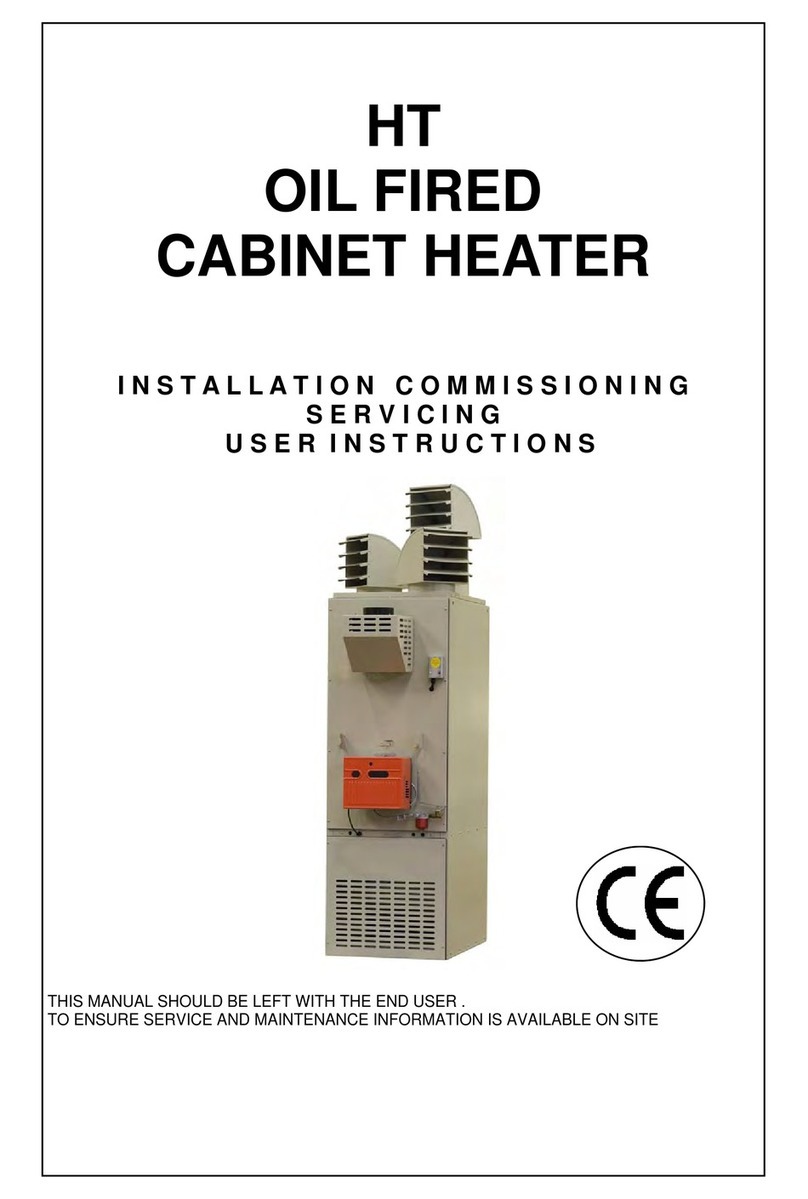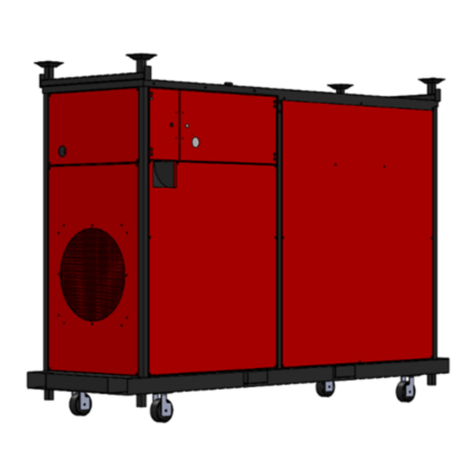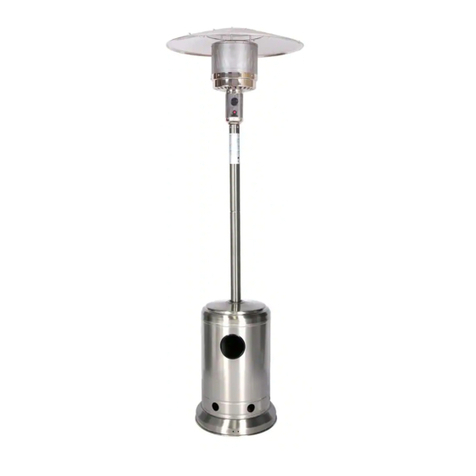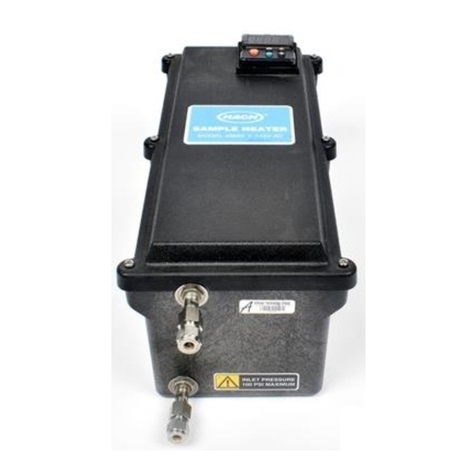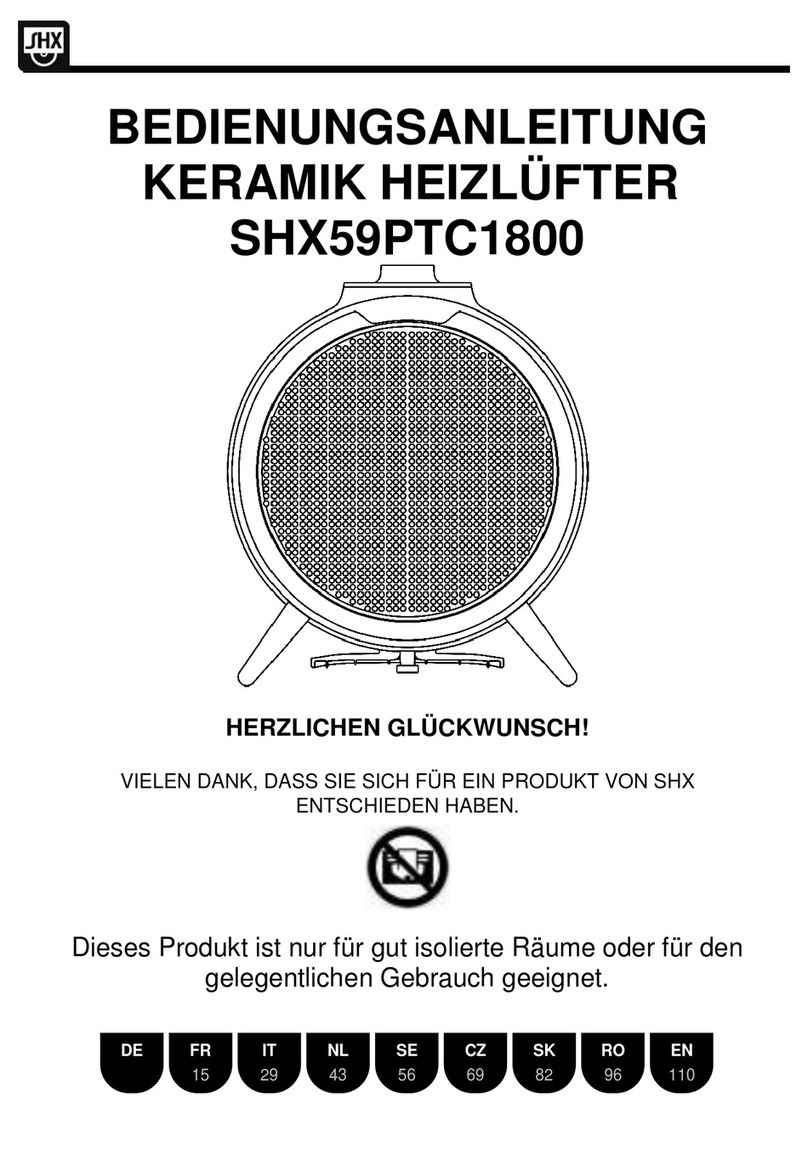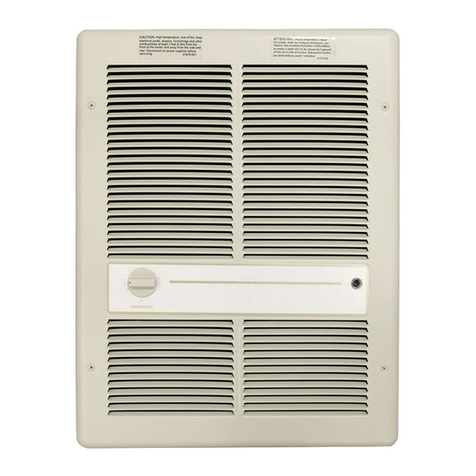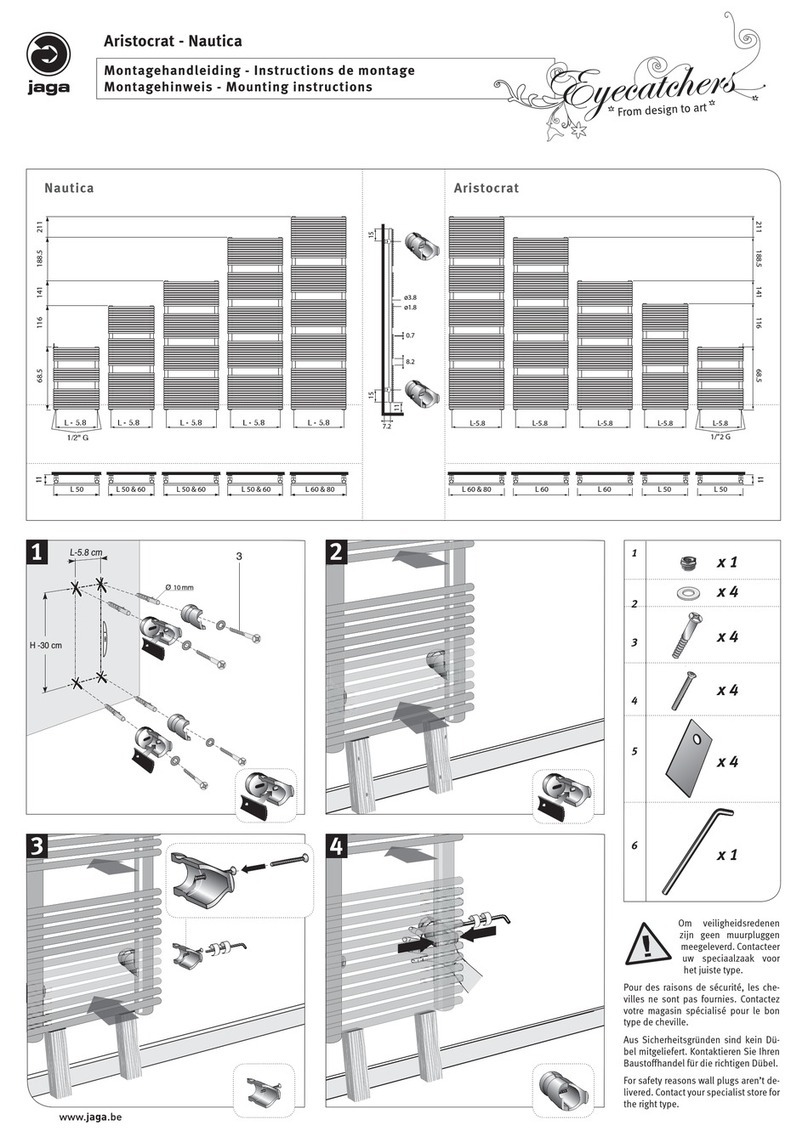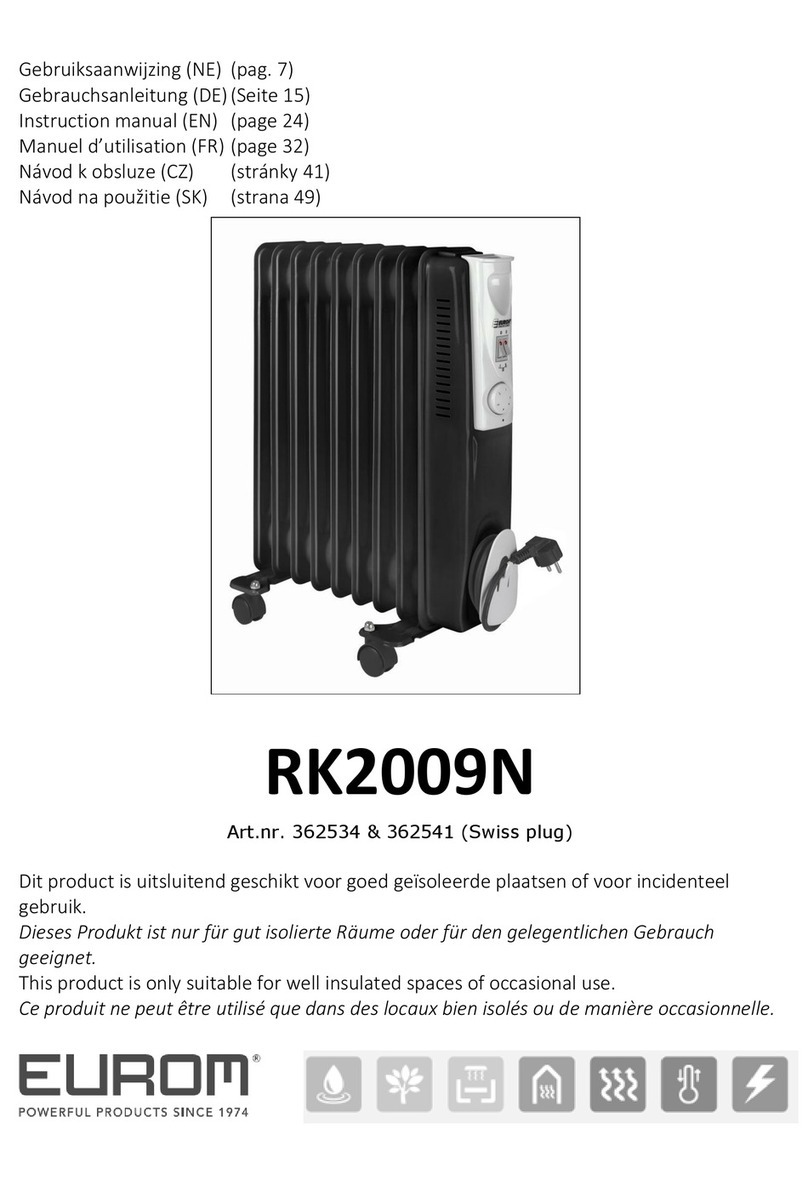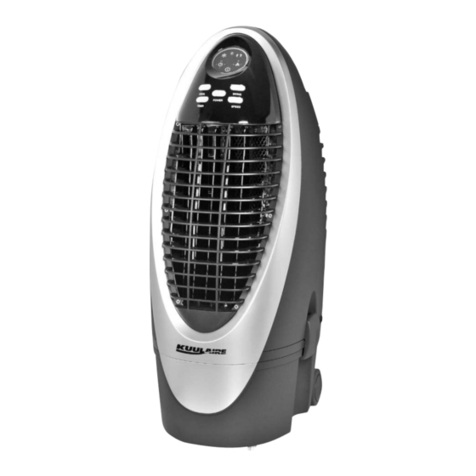Harry Taylor HT2000 Manual

1
HT
PV RANGE
NATURAL GAS (G20 I2H)
PROPANE GAS (G31 I3P)
TUBULAR CABINET HEATER
I N S T A L L A T I O N C O M M I S S I O N I N G
S E R V I C I N G
U S E R I N S T R U C T I O N S
THIS MANUAL SHOULD BE LEFT WITH THE END USER .
TO ENSURE SERVICE AND MAINTENANCE INFORMATION IS AVAILABLE ON SITE
WARNING

2
Section Contents Page No
1.0 Compliance Notices 4
1.1 Certificates of Conformity 5
1.2 General product Information 5
1.3 General Requirements 6
1.4 Delivery & Pre-installation Checks 6
1.5 Warranty 7
1.6 Special risk areas 7
2.0 Installation 8
2.1 Installation Clearances 8
2.2 Warm Air Circulation 8
2.3 Air Supply 8
2.4 Flue Installation 13
2.5 Electrical Installation 18
2.6 Gas Installation 20
3.0 Commissioning 20
3.1 Electrical Pre tests 21
3.2 Gas supply Pre tests 21
3.3 Ignition Sequence 21
3.4 Hand Over 22
4.0 Servicing 23
4.1 Servicing Procedure 23
5.0 Fault Diagnosis 26
6.0 Wiring Diagrams 28
7.0 Technical Data 43
7.1 Technical Data Common Information 43
Pre Purge information 44
7.2 Technical Data Heater Specifications 46
8.0 Parts Listing 46
9.0 All Dimensions 48

3
WARNING
ELECTRICAL INSTALLATION
When installing the heaters and using the remote controls option
ALL 8 WIRES MUST BE USED AT ALL TIMES .
IMPORTANT NOTICE TO INSTALLERS
Installers should satisfy themselves that the gas pipework installation is carried
out in accordance with all current legislation, Codes of Practice and
recommendations .
Additionally it may be necessary to protect the gas valves which form part of
the heater or burner assembly from potential pipe contamination particularly,
but not exclusively , where copper gas pipework is used.
In instances where copper pipework is to be used for all or part of a gas
pipework installation, including short length final connections then we advise
that installers consult with gas supplier or provider and satisfy themselves what
additional precautions may be necessary
Any reference made to Laws, Standards, Directives , Codes of Practice or other
recommendations governing the application and installation of heating appliances and
which may be referred to in Brochures, Specifications, Quotations, and Installation,
Operation and Maintenance manuals is done so for information and guidance
purposes only and should only be considered valid at the time of the publication.
Harry Taylor of Ashton Ltd cannot be held responsible from any matters arising from
the revision to or introduction of new Laws, Standards, Directives, Codes of Practice
or other recommendations.

4
1.0 Compliance notices
The Harry Taylor Ltd PV Range of warm air
heaters detailed herewith are manufactured
for Harry Taylor Ltd within a strictly
controlled environment within the
parameters of ISO9001.
These instructions are only valid if the
following country code is on the appliance
GB. IE. If this code is not present on the
appliance, it is necessary to refer to the
technical instructions which will provide the
necessary information concerning the
modification of then appliance to the
conditions of use for the country.
The Harry Taylor Ltd PV Range has been
independently tested and assessed, and
has been found to meet the Essential
Requirements of the following European
Directives.
Gas Appliance Directive (90 / 396 / EEC)
Machinery Directive (2006 / 42 EC)
Low Voltage Directive (2006 / 95 / EC)
Electromagnetic Compatibility Directive
(2004 / 108 / EC)
Product Liability Directive 85 / 374 / EEC)
The manufacturer has taken reasonable and
practical steps to ensure that Harry Taylor
Ltd PV Range of Heaters are safe and
without risk when properly used. These
heaters should therefore only be used in the
manner and purpose for which they were
intended, and in accordance with the
recommendations detailed herewith.
The heaters have been designed,
manufactured, assembled, inspected, and
tested, with safety and quality in mind, there
are certain basic precautions which the
installer and user should be aware of, and
they are strongly advised to read the
appropriate sections of the information pack
accompanying the heater, prior to
installation or use.
Harry Taylor Ltd supports all new products
being supplied to their customers with a
comprehensive information pack; this clearly
defines mandatory instructions for the safe
installation, use, and maintenance, of the
appliance (s).
Where proprietary items are incorporated
into Harry Taylor Ltd products, detailed
information and instructions are also
provided as part of the information pack.
It is the responsibility of the installer, owner,
user, or hirer, of such products supplied by
Harry Taylor Ltd, to ensure that they are
familiar with the appropriate information/
manuals, supplied by the manufacturer, and
that they are suitably aware of the purpose
of the manuals and the safety instructions.
In addition, operators must be suitably
trained in the use of the appliance so as to
ensure its continued safe and efficient use.
Harry Taylor Ltd has a commitment to
continuous improvement, and therefore
reserves the right to amend or change the
specification of the PV Heater Range
subject to agreement from The Notified
Body.
Contained within the text of the manual, the
words 'Caution' and 'Warning' are used to
highlight certain points.
Caution is used when failure to follow or
implement the instruction (s) can lead to
premature failure or damage to the heater or
its component parts.
Warning is used when failure to heed or
implement the instruction (s) can lead to not
only component damage, but also to a
hazardous situation being created where
there is a risk of personal injury.
The Harry Taylor Ltd PV Range of heaters
conform to the following European
Harmonised Standards.
BS EN 1020 Requirements for non domestic
gas fired forced convection air heaters for
space heating incorporating a fan to assist
transportation of combustion air and/ or
combustion products.
BS EN - ISO 12100-1:2003 & BS EN -
ISO12100-2:2003
Safety of Machinery - Basic Concepts,
General Principles for Design
Part 1 & Part 2

5
BS EN 60204 - Part 1 : 1993
Safety of Machinery - Electrical Equipment
for Machines Specification for General
Requirements
BS EN 60335 - Part 1 : 1988
Safety of Household and Similar Electrical
Appliances General Requirements
BS EN 55014 - 1993
Limits and methods of measurement of
radio disturbance characteristics of electrical
motor-operated and thermal appliances for
household and similar purposes, electrical
tools and similar electric apparatus
BS EN 50165 - 1997
Electrical Equipment of non-electric heating
appliances for household and similar
purposes, safety requirements
The Harry Taylor Ltd PV range of gas unit
heaters meet with the governments criteria
in respect of the Enhanced Capital
Allowance Scheme
1.1 Certificates of conformity
Declarations and Certificates are available
upon request from the Quality Control
Department at Harry Taylor Ltd
1.2 General product information
The Harry Taylor Ltd PV Range of 6 model
sizes have outputs from 29.4 to 144.0 kW,
PV heaters are suitable for operation on
Natural gas (G20) or LPG (Propane G31)
The Model Range is made up as follows
and are available in a configuration that will
allow for floor mounting only.
PV heaters have been approved for
alternative flue discharge arrangements but
each heater must be connected to its own
individual open flue these are detailed in
following page’s
Cabinet
Manufactured from electro-zinc coated steel,
finished in a durable stove enamelled
polyester powder paint.
Heat Exchanger
Manufactured from aluminised dimpled steel
tube formed into a W shape to give
enhanced efficiency .
Flue / Combustion Air Spigot
Each heater is fitted with two spigots both of
which are located on top of the appliance.
One of the pair is for connection for the flue
whilst the other is a screened combustion air
intake SEE SECTION 2.4 FLUE
INSTALLATION
Burner
The induced draught multi in-shot burner
assembly is manufactured from aluzinc
coated steel and mounted to a common
steel manifold which can be easily
withdrawn through the burner access
compartment.
Burner Control
The heaters are fitted with automatic
ignition for all models within the range.
Exhaust Fan
Combustion gases are evacuated to
atmosphere via an in built power flue venter
fan which is safety interlocked to the gas
valve via an air pressure proving device
Air Movement Fan
PV heaters are supplied with Centrifugal
fans suitable for ducted or free blowing
applications
Note
Neither asbestos nor soft soldered joints are
used in the construction or manufacture of
the Harry Taylor Ltd range of Heaters.
Model No 30 50 72
Output kW 29.4 49.0 72.0
Model No 95 120 145
Output kW 96.0 120.0 144.0

6
The materials selected for use can
withstand the mechanical, chemical, and
thermal stresses which they will be subject
to during foreseen normal use when
installed in accordance with the
manufacturers recommendations.
1.3 General Requirements
Caution
Before installation, check that the local
distribution conditions, nature of gas and
pressure, and the current state adjustment
of the appliance are compatible.
Warning
Unauthorised modifications to the appliance,
or departure from the manufacturers
guidance on intended use, or, installation
contrary to the manufacturers
recommendations may constitute a hazard.
Note
To ignore the warning and caution notices,
and to ignore the advice from the
manufacturer on installation, commissioning,
servicing, or use, will jeopardise any
applicable warranty, moreover, such a
situation could also compromise the safe
and efficient running of the appliance itself,
and thereby constitute a hazard.
This appliance must be installed by a
competent person and in accordance with
European, National, and Local criteria,
including any relevant standards, codes of
practice the requirements of the current
building Regulations (and in particular parts
J & L), Health and safety regulations IEE
regulations and any requirements of the
Local Authority, Fire Officer or insurers.
Relevant standards may include BS6230,
BS6891 and BS5588 parts 2 and 3
Prior to installation the following points
should be considered;
a) The position of the heater for the
optimum efficient distribution and circulation
of warm air.
b) The position of the heater relative to the
route of the flue.
c) The position of the heater relative to the
supply of gas.
d) The position of the heater relative to the
electrical services, wiring routes, and if
appropriate, any additional controls.
e) The position of the heater relative to the
supply of fresh air.
f) The position of the heater relative to
potential stratification / circulation problems,
which generally occur at higher levels and
which may be overcome through the
provision of a suitable de-stratification unit.
g) The position of the heater relative to
service and maintenance requirements.
Caution
The heater must not be installed within an
area where the conditions are unsuitable,
e.g. where the atmosphere is highly
corrosive, has a high degree of salinity, or
where high wind velocities may affect burner
operation. Suitable protection should be
provided for the appliance when it is located
in a position where it may be susceptible to
external mechanical damage from; for
example, fork lift trucks, overhead cranes
etc.
1.4 Delivery and pre-installation
checks
The heater is supplied wrapped in heavy
duty protective polythene, mounted on a
pallet.
On receipt of the heater, the following
checks should be carried out;
a) The model is as per order.
b) That it is undamaged.
c) That it is suitable for the gas supply and
pressure.
d) That it is suitable for the electrical supply.
If any of these points are not satisfied then
contact should be made with the Sales
Office at Harry Taylor Ltd as soon as
possible by telephoning 0161 3084550 In
the case of claims for damage, this must be
reported in writing within 24 hours of
delivery, in order to comply with insurance
criteria.

7
1.5 Warranty
The heater is supplied with a 1 year parts
and labour warranty and a further year on all
parts excluding consumable’ s.
In addition to this there is also a 10 year
time related warranty on the combustion
chamber.
The warranty commences from the date of
dispatch from the manufacturer, and is
subject to the terms detailed within the Harry
Taylor Ltd. 'conditions of business'.
Note (i)
The warranty may be invalidated if -
a) The warranty registration/commissioning
card has not been completed and returned
to Harry Taylor Ltd.
b) The installation is not in accordance with
the general requirements of this manual.
c) The flue arrangement and air supply for
the heater are not in accordance with the
manufacturers recommendations, codes of
practice, or similar standards.
d) Air flow through the heater is not in
accordance with the manufacturers
technical specifications.
e) Internal wiring on the heater has been
tampered with or unauthorised service /
repairs undertaken.
f) The main electrical supply input to the
heater has been interrupted during the
heating mode.
g) The heater has been subject to and
affected by the ingress of water in any form.
h) The heater is not operated at the rating(s)
laid down in the manufacturers technical
specifications.
i) The heater has not been operated or used
within the normal scope of its intended
application.
j) The manufacturer's recommended
minimum service requirements have not
been complied with.
Note (ii)
All warranty claims must contain the
following information to enable processing to
take place;
(1) Heater model
(2) Heater serial number
(3) Order reference/date of order, together
with full installation details (name and
address)
(4) Details or symptoms of fault
(5) Installers name and address.
Faulty parts must be returned to the Harry
Taylor Ltd Spares Department, the address
of which is provided on the rear cover of this
manual. Any such parts will undergo
inspection to verify the claim. Replacement
parts supplied prior to this may be charged,
and a credit supplied upon subsequent
validation of the warranty claim.
Consumable items are specifically not
included within the scope of the warranty.
Note (iii)
Notification is required immediately a fault is
suspected.
The manufacturer will not accept
responsibility for any additional damage that
has been caused, expense incurred, or
consequential loss resulting from any failure
of the heater(s).
1.6 SPECIAL RISK AREAS
Where it is proposed to install a heater
within a special risk area (e.g. an area
containing flammable vapours where petrol
engined vehicles are stored parked or
serviced where paint spraying occurs, or
where woodworking machinery or other
flammable dust creating process’s are
employed then restrictions, additional
regulations concerning the heater flue wiring
or controls may apply.
It is strongly recommended that you contact
Harry Taylor Ltd Technical before
installation.
Caution
When used in room sealed mode it may be
possible to install PV heaters in areas
containing flammable vapours, high levels of
airborne dust combustible dust chlorinated
or halogenated hydrocarbons degreasing
solvents styrenes other laminating materials

8
or airborne silicones. Harry Taylor Ltd
Technical should be contacted before
installation .
Failure to do so may invalidate or reduce
guarantee cover.
Plant Room Siting
Provided certain criteria are met it is
possible to install PV heaters within a plant
room heaters installed in plant rooms should
only be configured for use in room sealed
mode and provision should be made for the
positive connection of flues , combustion air
pipes, warm air discharge and return
ductwork where such a siting is a
requirement it is recommended that you
consult Harry Taylor Ltd Technical prior to
installation.
Additionally the maximum temperature
within the plant room should not exceed
320C
2.0 Installation
The location chosen for the heater must
allow for the fitting of an effective flue
system.
The location must also allow for adequate
clearance for the air supply, return air
circulation, gas supply, electrical supply,
whilst also providing good and safe working
access.
The heater must be installed on a flat and
level surface made from non-combustible
material, which is sufficiently robust to
withstand the weight of the heater and any
ancillary equipment.
Any combustible material adjacent to the
heater or flue system must be so placed or
shielded so that its surface temperature
does not exceed 650C.
PV free blowing heaters are at their most
effective when located as close to the
working area as possible. However care
should be exercised to avoid directing the
discharged air directly onto the occupants of
the area to be heated.
Where the passage of cold air causes
problems (e.g. by entrances, loading bays
etc) it is considered favourable if the heater
is positioned so as the discharge towards or
across the cold air source from a distance
from 1.5m - 6m dependent upon the size of
the entrance and the air throw
characteristics of the heater. On exposed
walls heaters should be positioned so as to
discharge towards, or along the length of the
exposed wall.
In areas where it is proposed that more than
one heater is to be installed, a general
scheme of circulation should be drawn up
and maintained, thereby offering the best
heat distribution. Air pressure within the
area heated and the outside air pressure
must remain the same, factors influencing
this would be the presence of extraction
systems, ventilation systems, and various
types of process plant.
2.1 Installation Clearances
The Heater must be installed within the
clearances indicated below in mm’s
2.2 Warm Air Circulation
The air heater should be positioned to
enable maximum circulation of discharged
warm air within the area to be heated, whilst
taking account of personnel within the area,
sources of cold air ingress, and
obstructions.
The air temperature rise on passing the heat
exchanger is typically around 33 0C
A full and unobstructed return air path to the
air heater must be provided
(see 2.4 Air Supply).
Where the heater is positioned to deliver
blown air through an opening in a wall,
Model Front Rear Lhs Rhs
30/50 700 400 150 150
72/95 840 400 150 150
120/145 840 400 150 150

9
return air intakes should be located so that
they cannot become blocked. Similarly
these intakes must be positioned so as not
to draw in odours, fumes, hazardous
vapours or particles.
2.3 Air Supply for Combustion and
Ventilation
Consideration must be given to the provision
of air for the purposes of combustion and
ventilation of the heated space, plant room
or enclosure where the heaters are to be
installed .
It is strongly recommended that BS 6230 is
referred to for further information concerning
ventilation requirements.
2.3.1 Heaters installed within the
heated space
Where heaters are installed within the
heated space (i.e. not a plant room , or
enclosure) then:
Combustion air or heater related ventilation
air will not be required if -
• The heaters are installed in room
sealed mode (ie with a positive
connection to atmosphere of both flue
and combustion air)
OR
• If the design air change rate of the
heated space is 0.5 air changes per
hour or greater
The design air change rate may be satisfied
by natural infiltration or by mechanical
ventilation.
Combustion air ventilation will be required if
• The heater(s) are installed with flue
only (ie without the positive connection
to atmosphere of a combustion air
duct)
And
• The design air change rate of the
heated space is less than 0.5 air
changes per hour.
Where heater(s) are installed without the
positive connection of combustion ductwork
within a heated space where air change rate
of that heated space is less than 0.5 air
changes per hour then it will be necessary
to provide either natural ventilation openings
to the heated space (Section2.3.1.1 refers)
or the mechanical ventilation of the heated
space (Section2.3.1.2 refers).
2.3.1.1 Natural Ventilation Openings
to the Heated Space
If the heater(s) are to be installed without
the positive connection of combustion air
ductwork within a heated space, and where
the design air change rate of that heated
space is less than 0.5 air changes per hour,
then provision for low level natural
ventilation openings only will be necessary.
The minimum free area of the low level
natural ventilation opening shall be
• 2 cm2for each kW of rated heat input
The low level natural ventilation opening
should be situated on an external wall and
be within 1000 mm of floor level for natural
gas and ideally at floor level for lpg gas
installations but in any event no higher than
250 mm.
The table below provides specific data for
each heater model as -
2.3.1.2 Mechanical Ventilation to the
Heated Space
In the event that the heater(s) are to be
Minimum Free Area Of
Ventilation Opening
High Level Low Level
cm2cm2
30 None 64
50 None 107
72 None 158
95 None 211
120 None 263
145 None 315
MODEL

10
installed without the positive connection of
combustion ductwork within a heated space
and where that heated space has a design
air change of less than 0.5 air changes per
hour and that the installer prefers to
mechanically ventilate the heated space
rather than provide ventilation openings then
• The heated space needs to be
mechanically ventilated so that the
design air change is 0.5 air changes
per hour or greater.
• It is a requirement that the mechanical
ventilation shall be of the !input! Type
with either natural or mechanical
extraction.
• Systems of mechanical extraction with
a natural inlet shall not be used.
• It is necessary to provide an automatic
means to safely inhibit heater(s)
operation should mechanical air
supply fail for any reason
2.3.2 Heaters Installed within a Plant
Room or Enclosure.
A plant room means a room housing the
heater plant and probably other items of
building service plant and would generally
have generous space for maintenance.
An enclosure is where the heater is installed
within a compartment or confined area
where space is limited.
Where heaters are installed within a plant
room or enclosure then provision for both
combustion air and / or air for general
ventilation will be required by means of high
and low level ventilation openings (sections
2.3.2.1 and 2.3.2.2 refer to plant room
applications and sections 2.3.2.3 and
2.3.2.4 refer to enclosure applications).
Alternatively the plant room or enclosure
may be mechanically ventilated (section
2.3.2.5 refers)
2.3.2.1 Natural Ventilation Openings
to Plant Rooms for Room Sealed
Heaters
For plant room applications the minimum
free area of ventilation opening will depend
upon whether the heater(s) is installed in
room sealed mode (ie with a positive
connection to atmosphere of both flue and
combustion air).
Or with flue only (ie without the positive
connection to atmosphere of a combustion
air duct)
Where the heater(s) is installed in a plant
room and in room sealed mode (ie with a
positive connection to atmosphere of both
flue and combustion air ) the minimum free
area of ventilation opening needs to be
• At high level 5 cm2for each kW of
rated heat input.
• At low level 5 cm2 for each kW of rated
heat input
The high level ventilation opening should be
sited on an external wall and positioned as
high as is practical and always within the top
15% of the wall height.
The low level natural ventilation opening
should be situated on an external wall and
be within 1000 mm of floor level for natural
gas and ideally at floor level for l.p.g gas
installations but in any event no higher than
250 mm.
The table below provides specific data for
each heater model as -
Minimum Free Area Of
Ventilation Opening
High Level Low Level
cm2cm2
30 160 160
50 267 267
72 394 394
95 527 527
120 656 656
145 787 787
MODEL

11
2.3.2.2 Natural Ventilation Openings
to Plant Rooms for Flued Heaters
Where the heater(s) is installed in a plant
room and in flue mode (ie without a positive
connection to atmosphere of combustion air
ductwork ) the minimum free area of
ventilation opening needs to be
• At high level 2 cm2for each kW of
rated heat input.
• At low level 4 cm2for each kW of rated
heat input.
The high level ventilation opening should be
sited on an external wall and positioned as
high as is practical and always within the top
15% of the wall height
The low level natural ventilation opening
should be situated on an external wall and
be within 1000 mm of floor level for natural
gas and ideally at floor level for l.p.g gas
installations but in any event no higher than
250 mm.
The table below provides specific data for
each heater model as -
2.3.2.3 Natural Ventilation Openings
to Enclosures for Room Sealed
Heaters
For enclosure applications the minimum free
area of ventilation opening will also depend
upon whether the heater(s) is installed in
room sealed mode (ie with a positive
connection to atmosphere of both flue and
combustion air).
Or with flue only (ie without the positive
connection to atmosphere of a combustion
air duct)
Where the heater(s) is installed in a plant
room and in room sealed mode (ie with a
positive connection to atmosphere of both
flue and combustion air ) the minimum free
area of ventilation opening needs to be.
• At high level 5 cm2for each kW of
rated heat input.
• At low level 5 cm2 for each kW of rated
heat input.
The high level ventilation opening should be
sited on an external wall and positioned as
high as is practical and always within the top
15% of the wall height.
The low level natural ventilation opening
should be situated on an external wall and
be within 1000 mm of floor level for natural
gas and ideally at floor level for l.p.g gas
installations but in any event no higher than
250 mm.
The table below provides specific data for
each heater model as -
2.3.2.4 Natural Ventilation Openings
to Enclosures for Flued Heaters
Where the heater(s) is in an enclosure and
in flue only mode (ie without a positive
connection to atmosphere of combustion air
ductwork ) the minimum free area of
ventilation opening needs to be:
Minimum Free Area Of
Ventilation Opening
High Level Low Level
cm2cm2
30 64 128
50 107 214
72 158 316
95 211 422
120 263 525
145 315 630
MODEL
Minimum Free Area Of
Ventilation Opening
High Level Low Level
cm2cm2
30 160 160
50 267 267
72 394 394
95 527 527
120 656 656
145 787 787
MODEL

12
• At high level 5 cm2for each kW of
rated heat input
• At low level 10 cm2for each kW of
rated heat input
The high level ventilation opening should be
sited on an external wall and positioned as
high as is practical and always within the top
15% of the wall height
The low level natural ventilation opening
should be situated on an external wall and
be within 1000 mm of floor level for natural
gas and ideally at floor level for l.p.g gas
installations but in any event no higher than
250 mm.
The table that follows provides specific data
for each heater model as -
2.3.2.5 Mechanical Ventilation to a
Plant Room or Enclosure
In the event that the installer prefers to
mechanically ventilate the plant room or
enclosure rather than provide ventilation
openings then -
• The plant room or enclosure needs to
be mechanically ventilated at the rate
of 4.14 m3/h of fresh air per kW or
rated heat input.
• It is a requirement that the mechanical
ventilation shall be of the ’input’ type
with either natural or mechanical
extraction. Where mechanical
extraction is selected then the
extraction rate should be 5%-10% less
than the input rate.
• Systems of mechanical extraction with
a natural inlet shall not be used
• It is necessary to provide an automatic
means to safely inhibit heater(s)
operation should mechanical air
supply fail for any reason
The table that follows provides specific data
for each heater model as -
Minimum Free Area Of
Ventilation Opening
High Level Low Level
cm2cm2
30 160 320
50 267 533
72 394 788
95 527 1053
120 656 1312
145 787 1574
MODEL
MODEL
Mechanical Ventilation
Rate for Plant Room or
Enclosure
M3/h
30 133
50 221
72 327
95 436
120 543
145 652

13
2.4 Flue Installation.
An integral flue spigot is fitted to all PV Air
Heaters thereby allowing the flue to connect
directly to the heater.
The design of the flue must ensure that it
can be disconnected to allow for cleaning
and servicing. All joints should be sealed
between the sections.
Warning On PV72 to 145 a Combustion
Air Plate is supplied as standard this
MUST be fitted in place of the
combustion air spigot if the heater is to
be installed in the flue only option.
It is essential that the products of
combustion are flued to the outside of the
building.
Each heater must have its own separate
flue, with a flue diameter of not less than is
detailed in section 7.2 within this manual.
The flue assembly must comply with all the
relevant regulations regarding height and
materials, and must terminate with an
approved flue terminal.
Care should be taken to ensure that the flue
terminal is not situated in a high pressure
area, the proximity of buildings and other
obstacles which will influence this must be
taken into account, preferably at the design
stage.
All PV Heaters are equipped with a built in
flue venter fan which prevents the re -
circulation of combustion products,
consequently an external draught diverter,
barometric damper, or anti spillage system
must not be installed. Such devices are
unnecessary on the PV range of heaters.
Horizontal flue installations must not
exceed those stated in the following
pages
Each 900bend corresponds to 1Mtr of flue
length
Each 450bend corresponds to 0.8 Mtr of
flue length
In order to provide adequate natural
draught, the minimum length of horizontal
flue must not be less than 1m.
For vertical flue installations the flue should
rise vertically where possible bends should
not exceed 450and the number of bends
should be kept to a minimum.
Maximum vertical flue length must not
exceed that stated in the following pages.
The temperature of the combustion products
can be as high as 1700C and therefore tend
to rise naturally within the flue. Unnecessary
bends and restrictions should therefore be
avoided.
Caution
It is imperative that the flue should be
properly sealed where it passes through the
roof, this can best be achieved by using the
approved method of roof flashing plate and
cravat. The flue spigot outlet on all PV
heaters is in vertical configuration.
Note
It should be noted that claims made under
warranty and attributed to the ingress of
water may not be considered especially if an
approved method of sealing has not been
used, or if the design of the flue has not
made provision for possible condensation
problems.
It is also recommended that BS5854: 1980
and BS5440: parts 1 and 2 are used as a
consultative document when considering
flue requirements.
If terminating through a wall only use
approved horizontal terminals
Provision for the disconnection of the flue for
servicing and inspection purposes must also
be made.
The position of the flue and its terminal
should be such that it does not impair the
combustion process. It should terminate in
an exposed position so as to allow the free
escape of flue gases without risk of their re-
entering the building through windows,
ventilation ports etc.

14
The following distances in mm’s should
be observed
200 below guttering or eaves
300 from corners or openings (windows
doors etc) and from other horizontal
terminals on same wall
1200 from a facing surface
1500 from another terminal vertically on the
same wall
2000 from ground level
The materials from which the flue is
constructed must be non-combustible,
resistant to internal and external corrosion,
and be capable of withstanding the stresses
and loadings associated with normal use.
When designing the flue system the
prevention of the formation and entrapment
of condensation must be a key
consideration.
Horizontal flue should be fitted ensuring a
slight gradient approx 20 towards the
terminal Where condensation is unavoidable
traps should be included to encourage the
condensates to flow freely to a point from
which they may be released, preferably into
a gully.
The condensate pipe from the flue to the
disposal point must be made from corrosion
resistant pipe of not less than 25mm internal
diameter.
If the flue passes through a wall, ceiling, or
roof made from combustible material then it
has to be sleeved so as to provide a
minimum of a 25mm void between the
exterior of the flue and the internal wall of
the sleeve.
For double wall flue pipe conforming to
BS 4543-2 and 3 the external skin and air
gap constitutes insulation to a standard
where no extra clearance from combustible
material is required other than normal
installation tolerances
Double walled pipe conforming to BS 715
the 25mm separation distance should be
measured from the outside surface of the
inner liner.

15
C32 Vertical Co axial flue Kit Option
In this configuration the heater is connected to a vertical flue system discharging the products of
combustion and bringing in the combustion air from outside the building in which the heater is
located.

16
Heater Unit Flue Exit HORIZONTAL Flue Exit VERTICAL
MIN. MAX. COMBINED LENGTH MIN. MAX. COMBINED LENGTH
30 m 1,00 6,00 1,00 10,00
50 m 1,00 6,00 1,00 10,00
72 m 1,00 8,00 1,00 10,00
95 m 1,00 8,00 1,00 10,00
120 m 1,00 8,00 1,00 10,00
145 m 1,00 8,00 1,00 10,00
B22 Single flue Option
In this configuration the heater is connected to a single flue pipe to discharge the products
of combustion outside the building either through the roof or through a wall. The air for
combustion is taken from inside the building.

17
Option C12
In this configuration the heater is connected to a horizontal flue system discharging the products of
combustion and bringing in the combustion air from outside the building in which the heater is
located.
The outlet / inlet must be through the wall and may be made with a horizontal coaxial concentric
terminal or two pipe

18
2.5 Electrical Installation
All electrical wiring and connections must be
in accordance with the relevant European,
National, and Local regulations as well as to
IEE Standards.
Harry Taylor Ltd PV Cabinets are available
either for 230/50/1ph or 415/50/3ph supply
Warning
Ensure that the electrical supply is
compatible to the heater.
ALL HEATERS ARE NEUTRALLY RESET
Ensure that the Electric and Gas supplies
are turned off before any electrical work is
carried out on the heater.
Also ensure that wiring cannot make contact
with any metal surfaces liable to be subject
to high temperatures, and where insulation
of the wiring could be impaired as a result of
such contact.
All PV models must be earthed.
Caution
The main electrical supply must not be
switched off or disconnected as a method
for stopping the heater, the exception to this
is in the event of an emergency, or when the
heater has been allowed to cool sufficiently
to prevent any damage from being
sustained to the heater or its controls (ie:
during servicing). Claims for damage will
not be considered if they have resulted from
incorrect wiring or the incorrect use of the
heater.
Each heater requires a permanent 230V
50Hz 1ph or 415V 50Hz 3ph electrical
supply, which must be wired through a fused
isolator fitted with a fuse of the correct rating
(see section 7.1). The correct supply
connection points for the live, neutral, and
earth.
Wiring diagrams are also detailed within this
manual, (section 6.0 ).
The electrical supply isolator should be
mounted adjacent to the air heater in an
easily accessible position to allow for
servicing isolation, or emergency shut off.
Electrical panel
Warning
Ensure that the mains isolator is turned OFF
before undertaking any electrical work on
the heater.
Access to the electrical panel is gained by
opening the front panel.
Warning
Ensure that all connections are secure and
that there are no loose strands which could
bridge across the terminals.
A minimum conductor size of 1.0 mm
(diameter) is required.
Remote Control Panels
Warning
Isolate panel before working on
heater
One electrical panel per heater is required,
unless heaters are specified for multiple
heater control applications. On no account
should more than one heater be connected
to a single time switch or thermostat.
The only exception to this is when a control
panel suitable for multiple heater
applications is supplied by the manufacturer.
Any ancillary electrical items e.g. room
thermostats , time switches, remote panels
etc, must be wired into the heater electrical
circuit in accordance with the diagrams
provided
Note
When external controls operate to switch the
heater OFF, power to the heater should
remain to allow the fan to continue to
operate to sufficiently cool the heater
thereby preventing damage to the heat
exchanger.
Fan limit control
( Situated inside the front panel)
These settings may require slight
adjustment on commissioning.
Fan control (white button) FAN ON 50°C
FAN OFF 30°C

19
The fan control switch features normally
open 230V contacts, and is wired to control
the live supply to the fan motor . When the
circuit is made, the fan will switch on when
the heat anticipator has closed the fan
switch contacts. When the thermostat or
time switch shuts down the burner, the fan
will continue to run until the thermal switch
has cooled sufficiently to prevent the
residual heat from damaging the heater or
its controls.
On start up the fan delay prevents air being
circulated until the desired temperature is
achieved
Limit control (red button) SET at 100c
An adjustable high temperature manual
reset limit control. If this control needs
resetting the cause should be determined
and rectified immediately.
Caution
The power supply to the fan must not be
interrupted, the only time when power
supply can be disconnected or interrupted is
during servicing or in emergencies.
If there is a requirement for the heater to be
switched off over night then the gas valve
circuit should be opened via a time switch,
etc, as per the wiring instructions and
diagrams supplied within section 6.0 of this
manual.

20
2.6 Gas installation
Warning
Please read notice on page 3 of this
manual
As there have been recorded instances of
the deposition of copper sulphide dust within
the valves and orifices of gas appliances as
a direct result of a reaction between the
hydrogen sulphide contained in some
natural gasses and copper pipe we
recommend that the heater(s) should not be
connected to any natural gas pipe
distribution system which utilizes copper
pipework, including final connections.
Instead steel pipework should be used
throughout.
In the event that it is impractical to use steel
pipework or where installers are obliged or
insist on using elements of copper pipework
within the installation then we strongly
recommend that the gas supplier be
consulted as specific conditions and
requirements may be necessary.
The PV Range of heaters are all
manufactured and pre set for use with
Natural Gas, and all feature 1/2” or 3/4” BSP
connection points. Prior to installation the
supply characteristics (gas type and
pressure) must be checked to ensure that
they are in accordance with the data plate
on the heater.
The gas supplier should check that the
meter and service connection to the heater
are capable of delivering the required
volume of gas, thereby ensuring that the
minimum burner pressure can be achieved.
Consideration should be given to the
pressure drop on single and multi heater
installations and the effect they may have on
other plant sharing the supply.
If it is necessary to fit a gas pressure
booster, the controls must include a low
pressure cut off switch which must be fitted
on the supply / inlet side of the booster. It is
also a requirement that the gas supplier is
advised prior to the installation or fitting of
the booster.
Each heater supply must be fitted with a
separate isolating cock positioned adjacent
to and upstream of the union which must be
sited outside the heater.
The isolating cock should be of the 900turn
type and should be clearly marked OPEN /
CLOSED it should also be installed so as to
fall to the closed position.
An approved gas jointing compound must
be used on all joints and unions and the
system purged and tested for soundness
prior to final connection.
The connection to the heater can be made
by way of either an approved flexible
coupling or rigid connection . Threaded
connections must comply to ISO 288/1 or
ISO 7/1 further information concerning
accepted European practice is detailed in
BS EN1020 1998.
The diameter of the pipework from the
isolating cock to the burner must not be less
than the diameter of the connection into the
multiblock.
Note
Reference to The Institute of Gas Engineers
publications Utilisation Procedures IGE/UP1
and IGE/UP2 together with reference to
BS6891 is strongly advised.
Nozzle Hoods
Ensure nozzle hoods are pointing in the
correct direction and are secured to top
plate by drilling through the holes provided
in the hood ring and securing with self
tapping screws.
Other manuals for HT2000
5
Table of contents
Other Harry Taylor Heater manuals
